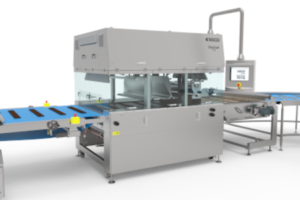Smarter technology for data capture, streamlining operations and automation processes can provide business with a critical competitive advantage.
The coronavirus pandemic has had a huge impact on practically every area of our daily lives – how we work, how we shop, how we socialise. And one of the key questions now being asked is how many of these changes are temporary, and how many will become the ‘new normal’.
Nevertheless, some of these areas of change were already well underway before this crisis; the arrival of the Covid-19 virus has merely further accelerated their progress. Internet shopping, for example, was a very strong growth sector long before the temporary closure of many retailers, and it is several years since supermarkets introduced home deliveries.
In the industrial sector, meanwhile, factory restrictions on external visits and the implementation of social distancing measures have brought into even sharper focus the benefits of increased automation and remote management of operations. However, these were already being implemented by many businesses as part of Industry 4.0 and the establishment of the Smart Factory.
Indeed, as the economic recovery continues, the advantages of Industry 4.0 in terms of increased productivity and efficiencies throughout the factory will remain just as relevant in increasingly competitive markets.
Automation is of course not a new concept. On the processing and packing line, equipment suppliers have over the years developed and enhanced automated solutions for practically every task and integrated these processes so that machines communicate and work in conjunction with each other.
Just as the integration of equipment streamlines processes in order to deliver greater efficiencies, the capture of data from multiple areas of the production line enables the building of a more complete picture. This allows companies to be proactive rather than reactive when it comes to improving practices or methods, by using comprehensive reporting to give a breadth of information.
The systems can provide direct performance analysis in real time, focusing on the most important key indicators for individual companies. Along with trends, batch information and statistics, there is also the possibility to compare the performance of different packing lines, even those located in different factories or countries, enabling best practices to be identified and shared throughout the business. The result can be a marked improvement in Overall Equipment Efficiency (OEE).
The wealth of information available can also support future planning and investment decisions. While it can be tempting to run cap-ex investments to the very end of their life to maximise spend, the performance data may help to identify areas where new technology could deliver more substantial long-term cost savings and a faster return on investment.
These types of monitoring systems need not be restricted to large scale companies. Smaller businesses, even those with a single line, can benefit just as much from integrated processes, in-depth data and information transparency, to help them maximise profitability and provide the foundations for future growth.
While the coronavirus pandemic may have focused minds on the benefits of new smarter technologies, it has always been important for companies to take a long-term view in their planning. Whether in times of boom or bust, businesses that can deliver high output at maximum efficiency will be best placed to succeed.
Data will therefore have an increasingly important role in the production lines of the future, giving companies the ability to make appropriate decisions quickly that will have a positive outcome on the entire production process.
Optical sorting machines
Christian Hofsommer, Area Sales Manager at TOMRA Food says: “Brand reputation is so important, yet in the confectionery business all it takes is one momentary slip in standards for this to be damaged and devalued. If just one batch of defective products should reach the end of the production line – or worse still, a foreign material potentially harmful to health – the commercial repercussions can be catastrophic. Which means that installing optical sorting machines on confectionery lines is crucial not only for product quality, but also to assure food safety.”
TOMRA’s sorting technologies can inspect materials flowing down a confectionery production line according to their colour, shape, and product characteristics. Four sorters are particularly well-suited to confectionery applications: the Genius and its successor, the TOMRA 5B, both belt machines, and the Blizzard and Nimbus free-fall machines. Belt machines are generally most suitable for distinguishing the shapes of objects on the line and for hard candies that might be too fragile to land from a free-fall. Free-fall machines, which scan and separate objects in flight, are better suited to looking for discolorations. Both types of machines can be located on the line before or after the product is oiled, depending on the factory layout. Even though oiling can make the product sticky and sorting trickier, TOMRA’s machines nevertheless perform with unrivalled effectiveness.
The machine best suited to smaller confectionery production facilities, because of its entry-level price and small footprint, is the Blizzard. This free-fall sorter does its detection work with pulsed LEDs and a combination of cameras, with a lighting system that needs very little calibration or maintenance. The LED’s different wavelengths detect foreign material, misshapen product, and discoloured product.
The Genius belt sorter also employs high-resolution cameras but combines these with advanced laser technologies. The Genius’ successor, the TOMRA 5B, employs on-belt 360-degree-surround cameras, a laser, and off-belt cameras. Capable of distinguishing the colour, structure, and shape of objects on the line, these belt machines detect cross-contamination, starch, and foreign materials, as well as identifying clumping and misshapen products. These machines are particularly well-suited to the North American market, where confectionery factories tend to focus on a single product and require foreign object detection to be supplemented by challenging shape analysis.
The Nimbus free-fall machine stands out for its capability to sort different products – such as sugar-free, with-sugar, and multivitamin sweets – with a variety of programs and applications on the same platform. This machine inspects product with specific laser technologies and combinations, and sorts according to colour, surface structure, and outline, with the ability to detect starch, foreign materials, and cross contamination. The Nimbus is in demand in European markets, where factories produce a variety of confectioneries and need to guarantee their customers a product free of cross-contamination.
The power to enhance business decisions
All of TOMRA’s sorting platforms are connectable to TOMRA Insight, a web-based data platform that gathers sorting data in near real-time and stores this securely in the cloud. Live data can be reacted to immediately (and remotely) to optimise machine settings; historical data can be processed into actionable information to unlock improvements in machine performance.
The extent of these improvements varies according to the type of food product being processed, but the potential is huge. Downtime can be reduced by monitoring machine health, supporting the management of predictive and condition-based maintenance, and preventing unscheduled machine shutdowns. Throughput can be maximised by evaluating throughput variations to optimise sorting equipment. Operating costs can be reduced by identifying gaps in production and analysing root causes. And sorting to target quality can be enhanced by having accurate material-composition data. Such data analysis will become increasingly valuable as we move into a digitised future, with the power to transform sorting from an operational process into a strategic management tool.
Solving labour-related challenges
In addition to taking care of food safety and product quality, sorting machines also help solve the challenges traditionally associated with employing manual sorters – an effective pill for headaches caused by labour scarcity, cost, variable effectiveness, and absenteeism. And whereas manual sorting is unavoidably subjective, imperfect, and more vulnerable to error when labourers are tired or bored, automated sorters can work for hour after hour with superior accuracy, consistent standards, and unflagging efficiency.
What’s more, the COVID-19 pandemic has heightened awareness of how greater automation reduces the health risks inherent when people have to work closely together. The more production steps the automated system takes care of, and the less manual intervention there is, the smaller the contamination risk. Extensive and reliable process automation ensures that the end-product is hygienic.
The pandemic’s logistical complications – travel limitations and social distancing – have also highlighted the value of TOMRA’s ability to complement on-the-ground support with remote assistance, Hofsommer says. With the recently launched smartphone app TOMRA Visual Assist, TOMRA field service engineers and customers can work closely together even when they are thousands of miles apart. The engineer can provide detailed advice just as if standing right in front of the customer’s machine, and both the engineer and the customer can share documents or annotate images to clarify and explain directions.
Hofsommer adds: “Another initiative proving helpful during these unusual times is TOMRA’s Online Demonstration Room. This makes it possible for confectionery producers to test-run TOMRA’s sorting machines, using their own infeed materials, even when they are unable to visit a TOMRA Test and Demonstration Centre in person.
“Tests are shown via a live video link, with the customer encouraged to ask questions, make requests, and direct one of the cameras showing the proceedings. After the test’s conclusion, observers are provided with a report which quantifies results precisely and in detail. This means that, despite travel restrictions, confectionery businesses can be certain of a machine’s capabilities before deciding whether to invest in the technology. An investment that pays back in many ways, not least in protecting that most valuable business asset, brand reputation,” he concludes.
Torsten Giese of Ishida Europe says:

“Automating systems helps to reduce manual operation and the interventions required, which in turn reduce overheads or enable the redeployment of staff to other areas. An automated process will also ensure an identical output every time and remove the risk of human error on the production line. Indeed, one of the most notable advances, and a key factor in delivering these benefits, has been the increasing integration of packing lines, with the ability for machines to exchange live data with centralised and remote systems.
At the same time, the importance of achieving maximum levels of uptime from packing equipment, remains as critical as ever to achieve the desired throughout, while also maximising yield.
An effective monitoring system, such as our own Ishida Sentinel software, is therefore invaluable in allowing individual machines, as well as complete single and multiple packing lines, to be monitored by both the equipment supplier and the processor and packer. This provides a high level of preventative maintenance where potential issues can be anticipated, and action taken before machines and packing lines experience even one minute of downtime.
Such systems also allow the planning of servicing and engineer visits, avoiding the need for any unscheduled calls which have been a particular challenge in the current pandemic.
Equally important, the data capture and analytical abilities of these systems are able to help companies manage their operations more profitably. Businesses need to know exactly how much it costs to get a product or pack out of the factory and be able to easily identify bottlenecks in production or areas where there are opportunities for improvement.
Capturing data allows companies to monitor remotely rather than deploying staff simply to monitor the systems. And the information gathered gives businesses the competitive advantage of being able to optimise production and work as efficiently as possible.”
 Christian Hofsommer, Area Sales Manager at TOMRA Food says:
Christian Hofsommer, Area Sales Manager at TOMRA Food says:
“Today’s sorting technologies achieve an accuracy that manual sorting simply cannot. The optical sorting machines offered by industry-leader TOMRA Food can be relied upon to detect and eject foreign materials, cross-contamination, product clumping, and malformed products. And at the same time as looking over the production line like guardian angels, automated sorters also enhance product hygiene, solve labour-related challenges, increase throughput, maximise yield, and gather data that can unlock further improvements in line efficiency.
All of this matters more now than ever before because consumers’ demands are changing. More people around the world are earning middle-class incomes and acquiring middle-class tastes. More are raising their expectations of food product quality. And fewer are prepared to tolerate product imperfections without complaining about them on social media platforms, where comments and photos can quickly reach and influence large audiences.
Today’s confectionery market is also being changed by the need for sustainability. More people are now aware that it is crucial to reduce energy use and greenhouse gas emissions and take better care of our planet’s limited resources. Retailers and consumers want to see food manufacturers addressing these concerns by implementing sustainable business practices and taking active measures to minimise food waste.
For all of these reasons – and because confectionery ingredients can be costly – sorters must remove unwanted materials and imperfect products without also throwing away good product. That’s why TOMRA’s sorters are designed, developed, and fine-tuned on-site to eject unwanted materials with minimal product loss. To minimise food waste and maximise yield, TOMRA’s machines achieve an exceptionally low good-in-bad reject ratio – and any good product ejected from the line can be recuperated when rejected materials are double-checked by running them through a sorter for a second time.”
Image credit: Ishida Europe
To stay up to date on the latest, trends, innovations, people news and company updates within the global confectionery market please register to receive our newsletter here
Media contact
Kiran Grewal
Editor, International Confectionery
Tel: +44 (0) 1622 823 922
Email: editor@in-confectionery.com









